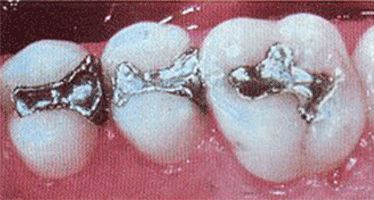The development of highly-durable composite materials has revolutionized dental techniques with results that rival Mother Nature. *Large fillings may require porcelain Onlays.
Tooth-Colored Fillings
150 years ago, dentists began using a silver-mercury compound called Amalgam for filling teeth. Not much changed until fairly recently. That’s why so many adults still have the old-style, dark fillings.
Containing about 50% mercury, amalgam fillings expand and contract in response to hot and cold foods and liquids. This action, over time, tends to fracture teeth from the inside. The tooth eventually breaks or the filling falls out leaving the cavity exposed.
Teeth with large silver-mercury fillings should be restored using all-porcelain onlays. But smaller fillings can be replaced with a new resin composite material. This remarkable composite not only seals and strengthens the tooth being restored, but its natural tooth color looks great!
What if I’m afraid of needles and drills?
If only decay (and not amalgam) is present, the Waterlase™ dental laser can be used for tooth preparation eliminating the need for shots and drilling. What’s more, the Waterlase™ method sterilizes the tooth which prevents any re-occurrence of decay under your new filling. The bonding action is maximized and the fillings will last longer.
Can children get tooth-colored fillings?
Tooth-colored fillings are ideal for restoring children’s teeth. And because we use the Waterlase™ method instead of scary anesthesia shots and dental drills, even the youngest clients enjoy their visits to Dr. Barton H. Foutz, DDS!










